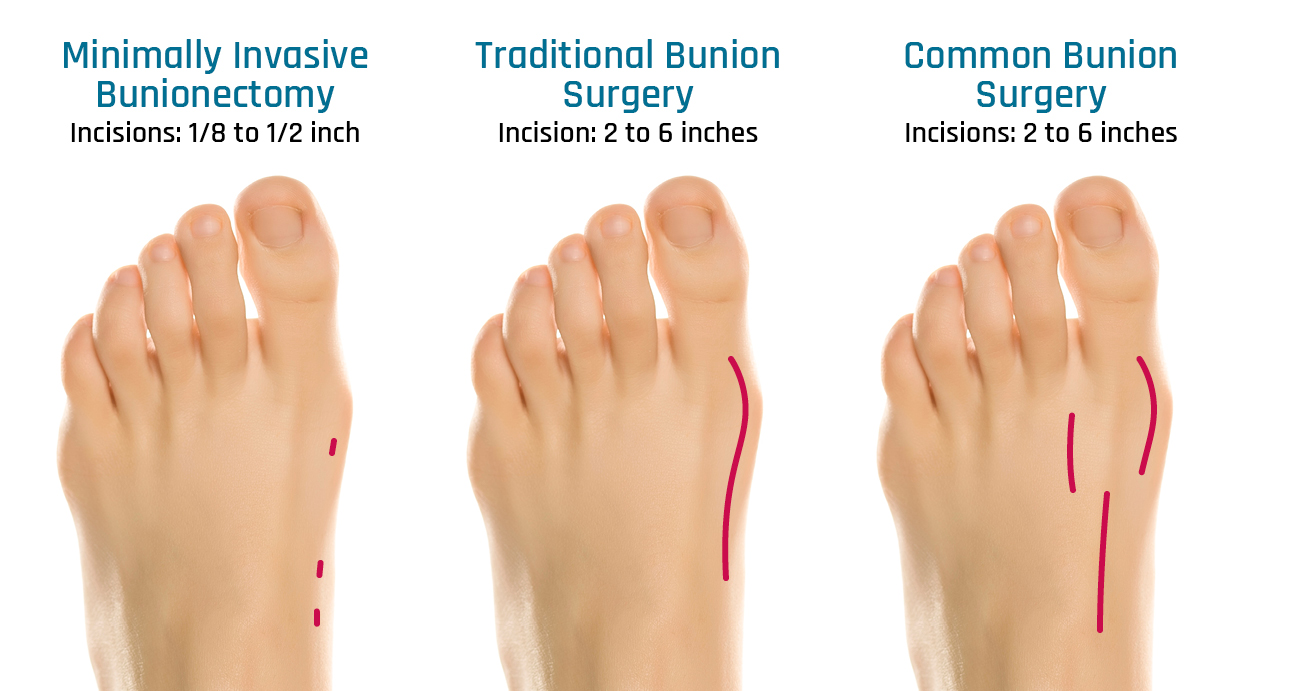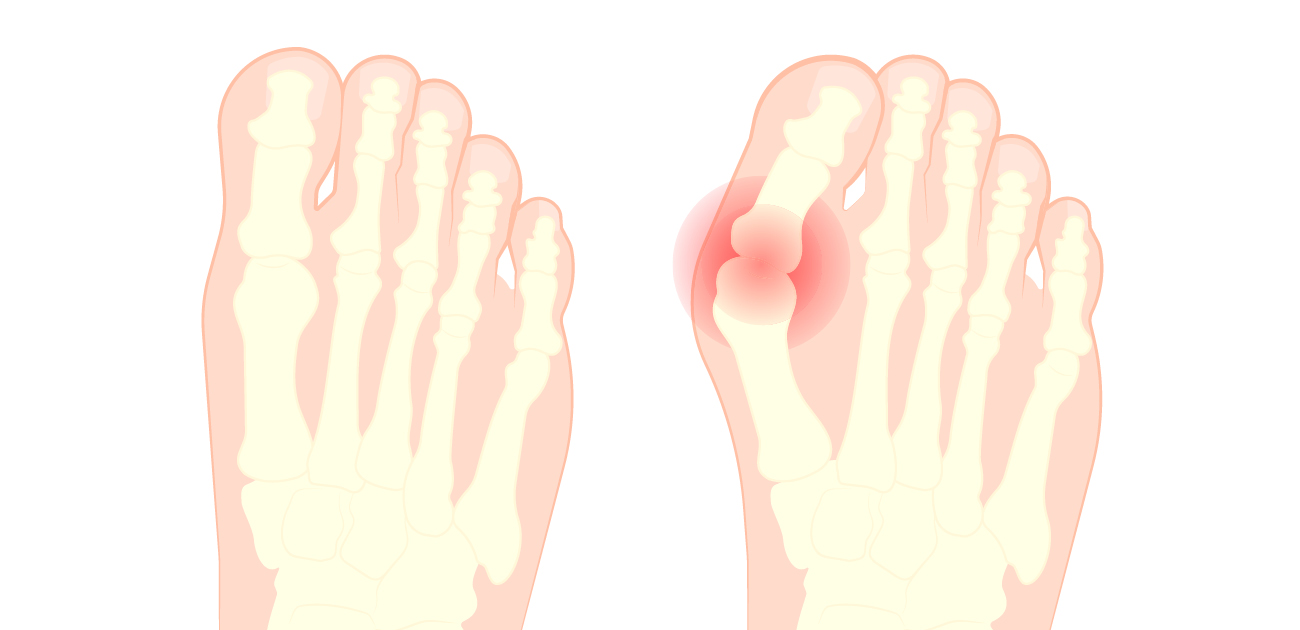Minimally Invasive Bunion Surgeons in Des Moines, Mason City, and Pella
Our doctors at East Village Foot and Ankle Surgeons recognize that when considering foot surgery, the level of expertise, years of experience, and training credentials a surgeon possesses are high priorities for patients. Our podiatrists are recognized as leaders within the foot and ankle industry and possess some of the top surgical skills in the Des Moines area and across the nation.
Why Choose Minimally Invasive Bunionectomy
Before suggesting surgery, our doctors at East Village Foot and Ankle Surgeons (EVFAS) consider all options for bunion correction. If it is determined that the best treatment plan is to surgically correct your bunions, one option we may recommend is minimally invasive bunion surgery. Not only does minimally invasive bunion surgery leave you with minuscule scarring and less risk of infection, this treatment option will get you back on your feet quickly.
Top 5 Benefits of Minimally Invasive Bunion Surgery
1. Small incisions. Minimally invasive bunion surgery is completed through ⅛-½ inch incisions in the skin promoting faster healing.
2. Minimal To No Scarring. Because the surgery is completed through small incisions in the skin, the cosmetic appearance is much more appealing compared to 2-6 inch incisions that are required for other surgical options.
3. Walk the Same Day of Surgery. Due to the quick surgery and no large incisions in the skin, patients can walk on the same day of surgery in a postoperative shoe.
4. Short Recovery Time. Our patients who undergo minimally invasive bunionectomy are more likely to transition into tennis shoes within 2-4 weeks depending on the progression of recovery.
5. Less Pain. Patients generally require less pain medication to manage pain after minimally invasive bunion surgery because the pain is reduced.
What is the least invasive bunion surgery?
Minimally invasive bunion surgery is the least invasive bunion surgery because the correction is completed through small poke holes in the skin with the doctor making surgical corrections using a live x-ray. The incisions for minimally invasive bunion surgery are only ⅛ to ½ inch, whereas traditional open bunion surgery involves 2–6-inch incisions.

Our team of podiatrists follow industry best practices for bunion removal and treatments and consider all viable options for treating each patient’s unique case. All of our surgeons offer top of the line treatment options. One of our surgeons, Dr. Kelsey Millonig has extensive expertise with specific fellowship training in minimally invasive bunion surgery and will utilize this surgical method when a patient’s needs require it.
3D Bunion Correction
Minimally invasive bunionectomy surgery is a 3D correction with additional benefits compared to traditional and/or common bunion correction surgery. The biggest difference between traditional bunion correction and minimally invasive 3D bunion correction surgery is the hardware used.
Traditional bunion surgery corrects the unstable joint through multiple 2–6 inch incisions in the foot and then fuses the joint using titanium plates which can have a big impact on recovery and long-term comfort.
Minimally invasive bunion surgery corrects the bunion through small incisions in the skin with a bone cutting burr. This method realigns the joint into a corrected position and uses zero-profile screws to stabilize it. The screws used in minimally invasive surgery reduce the amount of hardware discomfort compared to other methods of hardware fixation.
High-Tech Procedures Make EVFAS The Best Bunion Surgery Choice in Des Moines, Mason City, and Pella
When choosing East Village Foot and Ankle Surgeons you can rest assured you’re in good hands. The patient experience matters to us, which is why our foot and ankle clinics in Des Moines, Mason City, and Pella are equipped with state-of-the-art technology and our office staff provides exceptional care.
When it comes to our doctors, they are proud to provide expert care to Iowans! As Midwest natives, they are passionate about keeping locals healthy and active all year round. Every patient’s path to bunion correction and recovery is unique, and our doctors recognize this by asking the right questions and considering all options before producing a personalized treatment plan.
When minimally invasive bunion surgery is the best option for the patient, our team will walk you through the treatment and what you can expect before and after your bunion surgery in Des Moines, Mason City, or Pella. What makes minimally invasive bunion surgery so advanced is that the procedure is performed through small incisions while utilizing a live x-ray. This requires significant amounts of training to truly understand the 3D spatialization of this technique, and East Village Foot and Ankle Surgeons is proud to be a nationally recognized center of excellence by offering this advanced minimally invasive bunion surgery procedure.

Dr. Millonig is specially trained in this advanced technique of 3D bunion correction surgery. She completed a year-long reconstructive fellowship in minimally invasive surgery at the Rubin Institute of Advanced Orthopedics International Center for Limb Lengthening. She passes on her breadth of foot and ankle surgical knowledge by teaching this technique to other doctors around the United States.
Our Bunion Surgery Reviews
The impact of our services and the experience we provide to our patients matters most to us. We take pride in the treatment options and surgeries we provide because we know we’re helping locals stay active. Check out what our patients have to say about our work!

“After having two bunion surgeries on the same foot by other practitioners, I was hesitant to try a third surgery to relieve the pain. In meeting with East Village Foot & Ankle Surgeons, I trusted their plan and decided to proceed with their Minimally Invasive Surgery. I am pain free for the first time in years. The entire team was kind, knowledgeable, and patient with me through the entire process. I would highly recommend to anyone who lives with pain or discomfort to meet with the doctors at East Village Foot & Ankle.”
Cary C.
Minimally Invasive Bunion Surgery Recovery
Although recovery time is significantly shorter when you choose this advanced procedure, a rest period is still part of the process even with minimally invasive bunion surgery.
How soon can you walk after bunion surgery?
With minimally invasive bunion surgery, patients can typically walk with a special postoperative shoe the same day as surgery and are often back in tennis shoes within 2-4 weeks. Although recovery time is significantly shorter when you choose this advanced procedure, a rest period is still part of the recovery process.
Minimally invasive bunion surgery recovery time:
- Day of Surgery: Weight bearing in a special shoe with the ability to walk.
- 1–2 Weeks After Surgery: Keep area bandaged. Some patients may need to spend time in a boot or hard shoe to protect the foot.
- 2–4 Weeks After Surgery: Patients often transition into tennis shoes.
- 4–6 Weeks After Surgery: If no pain is present and X-rays show the bone is healing, patients can expect to resume light exercise including biking or swimming.
- 8–10 Weeks After Surgery: Patients can return to normal activity including wearing high heels and high impact exercise.
Every bunion case is unique. Depending on the type or severity of your bunion, recovery timeframes may vary. Minimally invasive bunion surgery recovery times are typically quicker than traditional bunionectomy recovery, however, patients should still be cautious of their limits. Our doctors at East Village Foot and Ankle Surgeons evaluate each patient's circumstances and medical history before endorsing a certain recovery period.
Preparing For a Successful Bunionectomy Recovery
Prior to having minimally invasive bunion surgery, it is important to prepare yourself and your home accordingly—this will set you up for a successful recovery. First and foremost, shop for groceries and essential recovery supplies and take care of simple tasks before surgery. As rest is important to getting you back on your feet, create a space within your home, preferably on a level that does not include stairs, where you can relax and most necessities are within reach. For more about bunionectomy recovery hacks, our doctor’s compiled a list of tips for a quick and successful recovery after bunion surgery.
Request Appointment
More Minimally Invasive Surgery Options at EVFAS
At East Village Foot and Ankle Surgeons, we offer additional minimally invasive surgery options aside from minimally invasive bunionectomy. Learn more about our other minimally invasive surgery options below.
Hammertoe correction: Hammertoes can be painful and typically limit the types of shoewear a patient feels comfortable wearing. Minimally invasive correction surgery is a great fit for someone who wants to get back to regular activity quickly with minimal scarring. There are two small incisions made during surgery. One on the side of the toe and another tiny incision at the tip of the toe. Your surgeon will use small buried hardware to keep the correction in place. Patients are walking in a special postoperative boot after surgery for approximately 2-3 weeks and then released back into regular shoewear.
Plantar fasciitis: A minimally invasive surgery for plantar fasciitis is a preferred choice for patients since it offers a shorter recovery time than traditional surgery. To perform this procedure, our foot and ankle surgeons will make a small incision on either side of the heel bone directly below the ankle. Next, our doctors will use a small blade to release the plantar fascia through a surgical scope. Patients are able to put pressure on their foot immediately following minimally invasive plantar fasciitis surgery (as tolerated) in a special postoperative shoe. Patients are typically back in regular shoewear after a few days of recovery.
Flat foot reconstruction: Flat foot reconstruction surgery is to relieve pain and restore function for patients who have low foot arches and conservative treatment such as orthotics hasn’t helped. During surgery the painful, damaged tendon on the instep is repaired or replaced with another tendon. A procedure known as a calcaneal osteotomy could also be performed at the same time (if needed). This involves making a cut in the heel bone and repositioned within the foot. Your surgeon will discuss with you what personalized procedures are best for your flat foot reconstruction procedure.
Charcot deformity correction surgery: The goal of Charcot correction surgery is to stabilize any fractured bones or dislocated joints and allow them to heal during recovery. Your surgeon may also realign or fuse the bones of the foot to better position them to bear weight. Charcot foot is a progressive condition that involves the gradual weakening of bones, joints and soft tissues of the ankle and foot. The deformity can lead to foot sores and ulcers, bone infection and, if not treated surgically, it could lead to amputation.
Ankle fractures: There are several types of ankle fractures affecting different parts of your foot. Ankles are made up of three bones and multiple ligaments, each working to keep your ankle healthy. Ankle fracture treatment depends on several factors and will need to be examined by your foot and ankle specialist. Not all ankle fractures require surgery, but all fractures require care by a professional foot and ankle specialist to heal properly. If surgery is required, the goal is to restore realignment and function, minimizing the potential for post-traumatic arthritis.
Ankle arthroscopy: For this type of minimally invasive procedure, our trained surgeons utilize a fiber-optic viewing camera and specialized surgical tools to operate in and around the ankle joint through small incisions. Ankle arthroscopy surgery can be used for a variety of ankle treatments and leads to quicker recovery times than traditional methods.
Trust East Village Foot and Ankle’s Bunion Surgeons in Des Moines, Mason City & Pella
If you’re considering minimally invasive bunion surgery or are experiencing foot pain, start with an evaluation at one of our clinic locations in Des Moines, Mason City, and Pella. Our doctors will work with you to develop a unique treatment plan to get you back to feeling like yourself. Schedule an appointment for a consultation today.